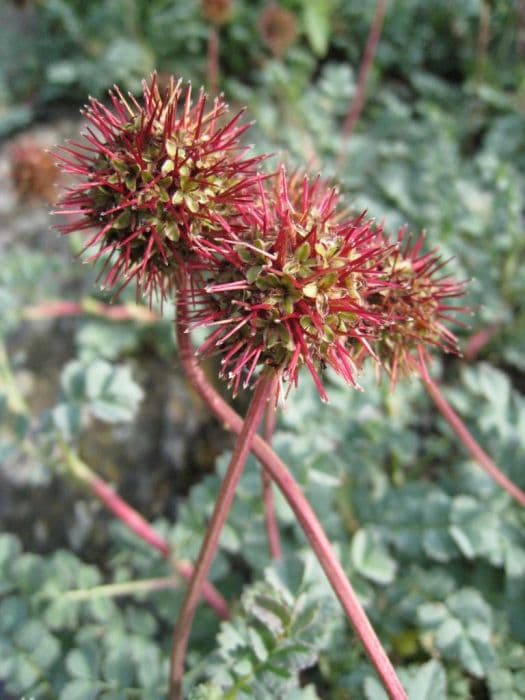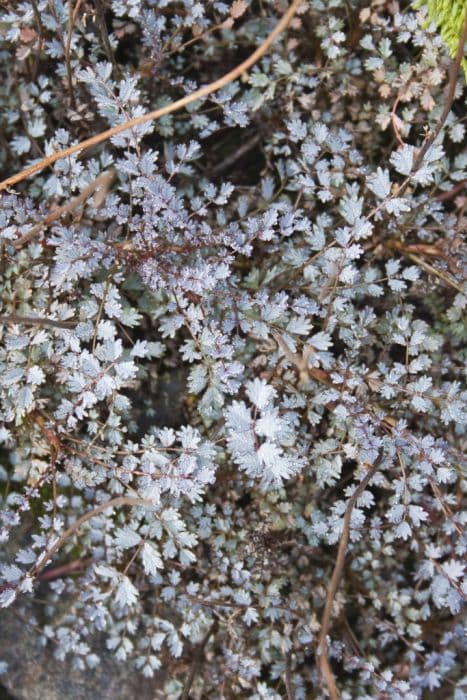English Rose Rosa Grace = 'Auskeppy' (PBR) (S)
![rose [Grace]](/_next/image?url=https%3A%2F%2Fplants-admin.emdemapps.com%2Fimages%2Fplants%2F%2Fimages%2F604b634d3e6f7.png&w=3840&q=75)
ABOUT
Rosa Grace, commonly known as 'Auskeppy,' is a cultivated variety of rose known for its exquisite beauty and is part of the English Roses collection. The plant produces flowers that are recognized for their distinct, cup-shaped blooms. These flowers often come in a soft, delicate pink hue that exudes a classic and romantic aesthetic. Each flower is densely packed with petals that unfurl from the center in a swirl, creating a lush, full appearance. The petals have a velvety texture that contributes to the rose's overall luxurious feel. The foliage of Rosa Grace is typically lush and abundant, comprising glossy, deep green leaves that provide a striking backdrop to the flowers. The glossy sheen of the leaves highlights the softness of the petals and enhances the plant's visual appeal. The leaves are also known for their leathery quality, adding to the plant’s healthy and vibrant look. Throughout its blooming period, Rosa Grace emits a delightful fragrance. The scent is usually described as a complex blend of classic rose with hints of fruitiness, a feature that many rose enthusiasts find particularly alluring. The aroma can be strong and is often considered one of the plant’s most charming attributes, carrying on the breeze and attracting passersby to take a closer moment of enjoyment. As an ornamental plant, Rosa Grace is admired for its graceful appearance and ability to complement a variety of garden settings. It often serves as a focal point in garden beds, borders, and as a specimen for rose gardens. The flowers are also excellent for cutting and bringing indoors, where they continue to radiate beauty and fragrance.
About this plant
 Names
NamesSynonyms
English Rose.
Common names
Rosa 'Auskeppy'.
 Toxicity
ToxicityTo humans
The plant Rosa Grace, commonly known as an English Rose, is not considered poisonous to humans. In general, roses are not toxic, and there are no well-documented cases of poisoning from ingesting parts of these plants. Therefore, consuming an English Rose is unlikely to result in symptoms of poisoning. However, it's always prudent to avoid eating ornamental plants as they are not intended for consumption and may have been treated with pesticides or other chemicals.
To pets
The plant Rosa Grace, commonly known as an English Rose, is not known to be toxic to pets either. Roses are generally considered safe for pets, and there are no significant reports of toxicity in animals such as dogs and cats from ingesting these plants. Symptoms of poisoning are not expected, but as with humans, it’s wise to prevent pets from chewing on these plants, especially if they may have been treated with chemicals that could be harmful if ingested.
 Characteristics
CharacteristicsLife cycle
Perennials
Foliage type
Deciduous
Color of leaves
Green
Flower color
Pink
Height
4 feet (1.2 meters)
Spread
4 feet (1.2 meters)
Plant type
Shrub
Hardiness zones
5
Native area
Cultivar
Benefits
 General Benefits
General Benefits- Beautifies gardens: Its elegant flowers add charm and a splash of color to any landscape design.
- Attracts pollinators: The plant provides nectar that attracts bees, butterflies, and other beneficial insects, supporting local ecosystems.
- Fragrance: The roses emit a pleasant scent that can enhance the sensory experience of a garden or space.
- Emotional Wellbeing: The visual appeal and fragrance of the roses can contribute to stress reduction and relaxation.
- Cultural Symbolism: The rose is often associated with love, beauty, and celebration, making it suitable for a variety of meaningful occasions.
- Versatile Landscaping: Can be used in borders, hedges, or as a stand-alone specimen, offering versatility in garden design.
- Long Blooming Period: Offers a long season of blooms, providing lasting beauty throughout the growing season.
 Medical Properties
Medical PropertiesThis plant is not used for medical purposes.
 Air-purifying Qualities
Air-purifying QualitiesThis plant is not specifically known for air purifying qualities.
 Other Uses
Other Uses- Natural Fabric Dye: The petals of roses can be used to produce a natural dye for fabric, offering a range of colors from soft pinks to rich reds, depending on the concentration.
- Floral Water: Rose petals can be distilled to create rose water, which is often used in cooking, especially in Middle Eastern recipes, to add flavor to pastries and sweets.
- Crafting Potpourri: Dried rose petals are a common ingredient in potpourri, adding a pleasant fragrance to a room when combined with other dried flowers and spices.
- Edible Delights: Roses are edible, and their petals can be used to decorate cakes or salads for an elegant touch; ensure they are free of pesticides if they are to be consumed.
- Natural Confetti: Biodegradable and environmentally friendly, dried rose petals serve as a natural confetti option for celebrations such as weddings.
- Bath Additive: Rose petals can be added to a hot bath for an aromatic and luxurious bathing experience, soothing the mind and skin.
- Eco-friendly Skincare: Roses can be infused in oils to create natural skin toners and moisturizers, as an alternative to chemically produced beauty products.
- Bookmark Crafting: Pressed rose petals can be used to create beautiful, natural bookmarks by laminating them onto paper or cardstock.
- Floral Ice Cubes: Freeze rose petals in water to create decorative ice cubes that can add an elegant touch to drinks at special events.
- Art Supplies: The different shades of rose petals can be used in artwork, such as for creating a collage or for eco-friendly, biodegradable glitter.
Interesting Facts
 Feng Shui
Feng ShuiThe English Rose is not typically used in Feng Shui practice.
 Zodiac Sign Compitability
Zodiac Sign CompitabilityThe English Rose is not used in astrology practice.
 Plant Symbolism
Plant Symbolism- Love: As a rose, the Rosa Grace symbolizes love. This age-old association stems from Greek and Roman mythology where the rose was tied to Aphrodite or Venus, the goddess of love.
- Beauty: Roses are universally admired for their complex structure and form, making them emblematic of beauty.
- Grace: Its very name, 'Grace', suggests refinement and elegance, which is a common symbolic meaning for roses that are found in beautifully composed gardens.
- Honor: Roses, particularly when given as a gift, can represent honor and appreciation for someone's accomplishments or character.
- Devotion: Due to the intricate care roses require, they are often associated with devotion, representing the gardener's dedication to their cultivation.
- Privacy: Historically, roses were planted in monastery gardens to symbolize a retreat from the outside world and hence can signify privacy or seclusion.
- Secrets: The phrase "sub rosa" or "under the rose" indicates confidentiality, suggesting that roses can symbolize secrecy.
- Mystery: The multiple layers of petals in a rose signify mystery, as they gradually unfurl to reveal their inner beauty.
 Water
WaterEnglish roses like Rosa Grace should be watered deeply but infrequently to encourage deep root growth. Generally, watering once a week with about 1 to 2 gallons of water per plant is sufficient, depending on the climate and soil moisture. During hot or dry periods, water twice a week. Avoid overhead watering to prevent leaf diseases; instead, use a soaker hose or drip irrigation to apply water directly to the base of the plant. In the winter, reduce watering as the plant will require less moisture due to dormancy.
 Light
LightEnglish roses, such as Rosa Grace, thrive best in full sun with at least six hours of direct sunlight each day. A spot that receives morning sunlight is ideal as it helps to dry the dew on the leaves, reducing the risk of fungal diseases. These roses can tolerate some light shade, especially in hotter climates, but too much shade can lead to poor blooming and weak growth.
 Temperature
TemperatureEnglish roses like Rosa Grace prefer a moderate climate. They typically do well in temperatures between 65°F and 75°F. While they can withstand temperatures as low as 32°F in winter dormancy, it is advisable to provide protection if the temperature drops much lower. Prolonged exposure to temperatures above 90°F may stress the plant and affect flowering. Ideally, plant Rosa Grace in a location where it can enjoy the warmth without suffering from extreme heat.
 Pruning
PruningPrune Rosa Grace in late winter or early spring to shape the plant and remove any dead or diseased wood. Pruning also encourages air circulation and new growth, which can lead to more blooms. Cut back by about one-third to one-half, making sure to cut just above a bud that is facing outward. Remove any weak or twiggy branches and deadhead spent flowers throughout the blooming season to promote continued blooming.
 Cleaning
CleaningAs needed
 Soil
SoilEnglish Roses like 'Auskeppy' prefer a well-drained loam with generous organic matter. Aim for a pH of 6.0-7.0. Mix equal parts garden soil, compost, and grit or perlite.
 Repotting
RepottingEnglish Roses such as 'Auskeppy' don't need frequent repotting; every 2-3 years is sufficient unless growth has stalled.
 Humidity & Misting
Humidity & Misting'Auskeppy' English Roses do best in moderate humidity levels but are adaptable and don’t require specific humidity control.
 Suitable locations
Suitable locationsIndoor
Provide bright light and air circulation for 'Auskeppy'.
Outdoor
Plant 'Auskeppy' in full sun and well-drained soil.
Hardiness zone
5-9 USDA
 Life cycle
Life cycleThe Rosa Grace, commonly known as Grace Rose, begins its life cycle when the seed germinates in soil with adequate sunlight and moisture, emerging as a seedling with a primary root and shoot. The seedling progresses to the vegetative stage, developing a robust root system, stems, and leaves, transitioning to a mature plant that becomes woody over time. As it reaches maturity, the Grace Rose starts to produce distinctive pink blossoms, usually from late spring to early summer, entering its reproductive stage. After pollination, often by insects, the flowers develop into fruit, called hips, containing seeds for the next generation. Once mature, the hips release seeds either naturally or through human or animal activity, continuing the propagation cycle. The plant then goes through a period of dormancy in colder months, reducing metabolic activities before resuming growth in the spring, completing its perennial cycle.
 Propogation
PropogationPropogation time
Spring-Early Summer
The Rosa Grace, commonly known as the English Rose 'Grace', is often propagated through softwood cuttings. This method is popular because it's generally straightforward and reliable for rose cultivars. The best time to take softwood cuttings is in late spring or early summer when the plant's growth is tender and green. The process involves cutting a 4 to 6 inch (approximately 10 to 15 centimeters) length of stem, which includes a couple of leaves and a node. The lower end of the cutting is then dipped in rooting hormone to encourage root development and planted in a moist potting mixture. It's important to maintain high humidity around the cutting, which can be achieved by covering the pot with a plastic bag or dome. Roots typically develop within several weeks, after which the new plants can eventually be transplanted into the garden.









